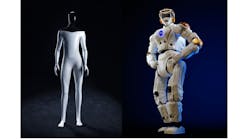So that Happened: Turning Off Lights at Navistar, March of the Androids, Royal Ketchup Headache
Editor’s note: Welcome to So That Happened, our editors’ takes on things going on in the manufacturing world that deserve some extra attention. This will appear regularly in the Member’s Only section of the site.
Companies Commit to Buying Technology that Assists Disabled
Intel and Merck are among 20 companies that earlier this month joined the Procure Access Initiatives, a program by Disability:IN which encourages companies to buy and sell technology as well as products and services that are accessible, usable and inclusive to those with disabilities.
Disability:IN has partnered with more than four hundred corporations to create long-term business and social impact through its disability inclusion benchmarking tool the Disability Equality Index (DEI).
“More than 32 years after the Americans with Disabilities Act, there is still a lack of accessibility in technology and other products and services, which continues to create barriers for people with disabilities in employment and society,” says Jeff Wissel, chief accessibility officer of Disability:IN, in a statement. “This is a crucial step in building a disability-inclusive workforce, customer base and supply chain.”
The initial 20 signatories and future members of the Procure Access initiative aim to identify obstacles facing technology buyers and sellers and promote the sharing of information about accessibility gaps and roadmaps.
Turn Stuff Off
There are all sorts of ways to reduce energy costs and usage in manufacturing, and Navistar Inc. is doing many of them. Efforts by the truck maker, now part of Volkswagen’s Traton Group since last year’s merger, include participation in demand response programs, utility rebates, energy treasure hunts and other Department of Energy programs. Several plants are receiving training on ISO 50001, a standard that focuses on energy management.
The focus on energy management, and particularly energy efficiency, isn’t new for the manufacturer, says Terri Sexton, a Navistar corporate manager of environmental and energy affairs, but it is expected to accelerate with the Traton merger and the European perspectives on climate change and sustainability that accompany it. (Traton is based in Germany.) The EU has set a long-term climate-neutral vision as well as emissions targets. Additionally, earlier this year, Navistar CEO Mathias Carlbaum said sustainability will be a focus at Navistar.
Sexton shared her insights at the Ohio Manufacturers’ Energy Conference, held earlier this month, with a talk focused on energy efficiency. She noted that historically energy reliability rather than efficiency has been the focus in manufacturing operations. It’s a mindset that has been a barrier to bigger efficiency gains, she suggested. So, too, has been a perception by some that energy efficiency is costly. Rising energy prices may be changing that perception.
Sexton’s advice: “Make energy efficiency part of [operations], part of product and quality and production.”
And don’t forget the simple solutions. “Turn stuff off when you’re not at work. It’s common sense but you would be amazed at how much energy is used during production versus off production. Sometimes it’s about the same.”
To hear more about Navistar’s operational excellence journey, attend the Manufacturing & Technology Show in Cleveland, Oct. 18-20. Navistar Executive Vice President Mark Hernandez will detail how the company is using its new San Antonio plant as a testbed for numerous IIoT and Industry 4.0 technologies.
I, for one, Welcome our Robotic Overlords
Are we finally ready for the robotic future envisioned by Isaac Asimov and Philip K. Dick? Will we soon have C3P0-style protocol droids assisting us in daily life? A few companies are pushing in that direction.
Next week, Tesla plans to unveil to the latest version of Optimus, its humanoid robot for assembly lines. And, Austin, Texas-based Apptronilk recently inked a deal with NASA to commercialize its experimental lineup of person-shaped machines.
Apptronik’s early models have the unique distinction of making Boston Dynamics’ creepy robot dogs feel friendly by comparison. Draco and Hume models are legs-only robots (Wallace and Gromit fans, imagine “The Wrong Trousers” short film for reference). Dreamer and Astra aren’t quite as bad, representing human upper torsos and heads.
Valkyrie, part of a NASA research project, is their combined, upper-and-lower human halves model, and it’s more lifelike.
“The robots we’ve all dreamed about are now here and ready to get out into the world,” said Jeff Cardenas, CEO and co-founder of Apptronik. “These robots will first become tools for us here on Earth and will ultimately help us move beyond and explore the stars.”
For anyone paying attention, yes, robots helping us explore the stars was the plot of dystopian sci-fi classic Blade Runner.
Tesla’s Optimus robot, unveiled as a concept about a year ago, represents years of effort to solve a long-standing automation problem in the auto industry. General Motors began using industrial robots, Unimate, in 1959, and robots now handle most welding, painting and sealing operations in car plants. But people are much better suited for vehicle final assembly—connecting wires and hoses, applying trim pieces, installing seats, etc…
Unlike paint with its chemicals or body weld with its heat or stamping with its sharp edges, final trim and assembly are human-friendly. Robots excel at repetitive tasks, but final assembly is highly variable, keeping human minds engaged.
It’s a lesson that Tesla CEO Elon Musk learned the hard way when it launched its Model 3 electric vehicle.
Initially, Tesla tried to automate as much of final trim and assembly as possible, and the robots weren’t up to the task. Production fell behind badly, and the company had to set up extra assembly lines under tents in its parking lots to handle the work. The operations needed people, not machines.
Or maybe not? Optimus robots could work alongside people in those trim and assembly areas, using their human forms to do what traditional industrial robots could not—reach into tight spaces, bend around small openings and manipulate a wider range of tools.
Will these new humanoid robots be practical, affordable or effective? Are we going to link them to computer systems? We could use the cloud and call the system Skynet. What could possibly go wrong?
Insects on an Industrial Scale
Is industrial insect farming having its day in the sun? (Or would that more likely be in the shade?)
We’re not about to proclaim ourselves experts in this corner of the food economy, but we couldn’t help but notice back-to-back funding announcements this week. First, Singapore-headquartered Nutrition Technologies said it had raised $20 million from a group led by PTT Ventures and featuring six other firms, including Sumitomo Corp. Then Paris-based Innovafeed said it had secured $250 million in backing from the Qatar Investment Authority and a handful of others, including agribusiness giant ADM and Cargill.
The Innovafeed team plan to use part of their new proceeds—this was the company’s Series D round—to build a 280-job plant in Decatur, Illinois, where it expects to begin producing 60,000 tons of protein annually in 2024. The six-year-old company will crank out black soldier fly protein for animal and plant use and, down the road, human food.
The involvement of big names in these funding rounds (including Temasek, Singapore’s state investment company) makes it clear that this isn’t a flash in the plan or unproven test run. Nutrition Technologies executives say the market will be worth about $340 million this year but grow to $1.3 billion by 2027. Add in the fact that industrial insect production feeds into many aspects of food security, clean energy and sustainability more broadly and it’s likely we’ll see many more headlines soon.
—Geert De LombaerdeRoyal Re-Do: Twining’s and Others Must Change UK Labels After Death of Queen Elizabeth II
In what IW Editor-in-Chief Robert Schoenberger has called “possibly the only manufacturing story reacting to the Queen’s death,” a variety of food and beverage companies will have to change their labels after Queen Elizabeth II’s death earlier this month.
Twining’s tea, Gordon’s gin and Heinz ketchup are among the companies that display the British Royal Arms on their UK packaging. The Arms depict a lion and a unicorn—symbols of England and Scotland, respectively—and the words “by appointment to Her Majesty,” and only companies that hold a Royal Warrant are allowed to display it on their packaging in the UK. Those warrants expire on change of monarch, according to the Royal Warrant Holder Association’s website, though companies may continue to use the label for two years before they have to apply for one under the new King.
The change is unlikely to affect as much packaging in the U.S. as it is overseas, though—where the UK Heinz ketchup bottle depicts the Arms, the U.S. version instead simply says the company name and “57 varieties” slogan.
According to the RWHA, the tradition of royal charters for preferred manufacturers of the British monarch goes back to about the twelfth century, when Henry II granted one to the Weavers’ Company. Since then, the monarchy has traditionally issued warrants to companies allowing them to depict the arms in exchange for providing services or products to the Royal Household.




